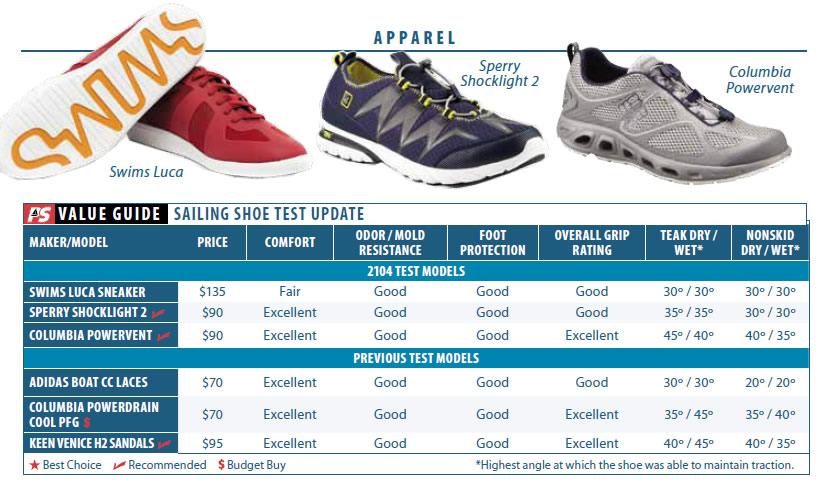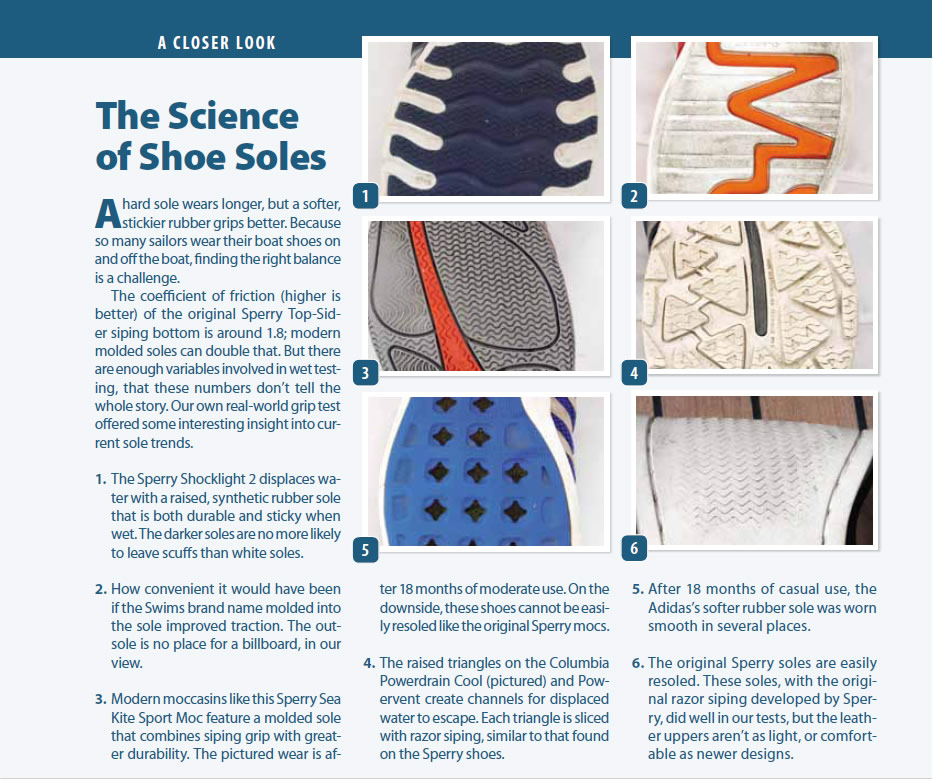
About 20 years ago, the conventional sailing moccasin started losing ground to more specialized footwear for sailors, but only recently have major sports apparel companies like Adidas and Puma entered the on-the-water footwear fray. Boat shoe style has come a long way since Paul Sperry-whose namesake company, Sperry, originated the nonskid grooved-sole moccasin-carved a zig-zag pattern into an old gumshoe back in 1935.
The hybrid sneaker-water shoe market continues to expand, with enough varieties to make a sailors head spin. Three new designs crossed our deck recently, warranting review, so we put them through their paces, comparing them to some past favorites.
For this shoe-test update, we looked at three brand-new boating shoe styles: the Shock Light 2 from sailing shoe giant Sperry; the Powervent PFG from outdoor apparel specialist Columbia Sportswear; and the Luca sneaker from the Norway-based SWIMS, which got its start in 2005 making slip-on multi-colored galoshes. We compared their performance to past top picks that are still being long-term tested: Adidas Boat CC Laces (PS, December 2012), Columbias Powerdrain Cool PFG (PS, May 2013), and the Keen H2 sailing sandals (PS, July 2010).

How We Tested
We followed the same test protocol and rating guidelines we used in past shoe tests. We evaluated each shoe on comfort, construction quality, foot protection, grip on an incline, draining ability, and resistance to odor and mildew.
Grip ratings were determined by having testers don each pair of shoes and stand on an incline testing device. The tests began with an incline of 20 degrees and progressed intermittently to greater angles of heel to find out at what point each shoe lost traction. We repeated the process for each shoe on wet and dry teak and nonskid panels.
To assess the shoes resistance to mold and odor, we soaked them in salt water, and then put them in a black plastic bag for a week; these results are listed in the accompanying Value Guide. We have found that the real shoe stink comes from bacteria on the feet when wearing the shoes, and only long-term testing can determine whether the test shoes designs fight odor from feet bacteria; look for those results in future test updates.
Columbia Powervent PFG
Columbia recently introduced the new Powervent PFG shoes, which are similar to the Columbia Powerdrain Cool shoes we reviewed last year. Testers deemed both models to be lightweight and comfortable, and to offer Excellent traction.
The Powervents layered mesh upper offers good ventilation and fast draining, and it enables the shoes to dry more quickly. It was easy to clean and somewhat resistant to stains; potential stains like fish blood came off with little scrubbing.
The cushioned footbed, which has small holes, covers the shoes perforated insole. This design not only hastens drainage, and it also means better ventilation-a big plus for comfort and odor resistance. A molded plastic toe cap adds foot protection.
Testers noted that the shoes were lightweight, even when wet, and that the cushioned Techlite midsole was comfortable enough for all-day wear, even through long hours of standing on nonskid decks and walking ashore. The bungee cord closure system afforded fast, easy donning and doffing. We also noticed that the bungee was less stretchy than on other shoes, like the Keen sandals, so the Powervents stayed snug on our feet longer without having to re-cinch the cord.
The non-marking Powervent outsoles are identical to those on the Powerdrain shoes, featuring raised triangles with razor siping. Both Columbia models earned top ratings in grip tests, and both have been proven to offer good onboard traction on nonskid.
The Powerdrain shoes are still holding up well, although after a year of hard use, the odor resistance is pretty much gone.
Bottom line: The new Powervent shoes offer top-notch drainage, breathability, and comfort. Their traction-test performance matches our past top picks. We Recommend them.

Sperry Shock Light 2
The Sperry Shock Light 2 sneaker is a lightweight athletic shoe, weighing only 6.7 ounces. The bungee-cord closure system offers the security of a lace-up with the donning ease of a slip on, but the downside is that the bungee may stretch out over time.
The Shock Light 2 has a fairly well-made nylon and mesh upper with sturdy, thick rubber around the front for toe protection. Wave-siping on the bottom of the shoe adds a touch of Sperrys classic non-slip protection. The shoes werent the top performers in traction testing, but they were in the top tier, and did better on teak than on fiberglass.
The shoe has a compression-molded footbed with a removable insole for quicker drying-an important feature because the shoes have no vents or drains on the sides or bottom of the shoe, making water drainage slow and drying time longer.
The Shock Light 2 features ASV technology in the heel, which Sperry claims absorbs vibration and reduces shock significantly. We didnt test specifically for this, but testers noted that wearing the shoes, even for long periods, was akin to the comfort of wearing a pair of running shoes. New for spring 2014, they sell for $90.
Bottom line: This was one of the more comfortable lightweight boat shoes weve worn. If you spend a lot of time standing at the helm or walking on shore excursions, you will appreciate the shock-absorbing sole. The Shock Light 2s are Recommended.
SWIMS Luca
SWIMS Luca sneaker is a lightweight athletic shoe with a non-marking, anti-slip sole and a breathable, unlined mesh upper. The heavy rubber outsole provides traction on par with the Adidas we tested a few years ago.
The Luca has a removable, antibacterial insole designed to prevent bacterial growth in the shoe, and the ventilated sole aids in that endeavor. The shoe body is quick drying, breathable nylon, and the outer shell is flexible and well made with tight, protected seams.
The SWIMSs style is a fusion between a lightweight sneaker and a summer loafer. The shoes lace up, which means they stay on better but are more work to take on and off than those with the bungee-style closure.
Bottom line: While this shoe is well made, the plastic-ish materials and thin padding did not appeal to testers. And while its grip test performance was average, other shoes weve reviewed are better suited for sailing life.
Conclusion
The leather sailing moccasins drop in popularity can be partly blamed on the fact the shoes absorb water, are relatively heavy, and tend to stink after a few uses (although weve yet to find a shoe that lives up to its odor-free claims). Sneaker-style sailing shoes generally have cushioned soles, dry faster, and are lighter weight. Some of the newer construction materials resist mold and mildew better than leather (or pleather). However, weve found that many of the newer shoes feature soles aimed at river-rafters, creek hopping, fishing, or canoeing-not sailing. The cross-over Keen Venice H2, a rugged sandal-type shoe that did well in 2010, was an exception to this rule, beating many of the more conventional designs, especially in the traction tests.
The other issue with the athletic shoe styles is durability. Weve yet to find a shoe with a fabric upper that lasts as long as a good pair of leather Sperry mocs-which, if well taken care of, can last decades (with resoling).
Sperry and Columbia have done consistently well in our shoe tests, and these new models are no exception. People with joint issues will appreciate the added cushion in the soles. The Sperry Shock Light was bested (barely) in traction tests by Columbias Powerdrain and Powervent, and by the Keen sandals. We Recommend these Sperry, Columbia, and Keen shoes, as they all offer good grip, fast drainage, and breathability. The older Columbia can sometimes be found at lower prices, making them the Budget Buy. The Swims would not be one of our top choices for a sailing shoe.



































